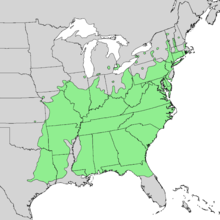Mockernut hickory
| Mockernut hickory | |
|---|---|
 |
|
| The nuts of white hickory | |
| Scientific classification | |
| Kingdom: | Plantae |
| (unranked): | Angiosperms |
| (unranked): | Eudicots |
| (unranked): | Rosids |
| Order: | Fagales |
| Family: | Juglandaceae |
| Genus: | Carya |
| Species: | C. tomentosa |
| Binomial name | |
|
Carya tomentosa Sarg. |
|
 |
|
| Natural range of Carya tomentosa | |
| Synonyms | |
|
Carya alba L. |
|
Carya alba L.
Carya tomentosa, (mockernut hickory, mockernut, white hickory, whiteheart hickory, hognut, bullnut) is a tree in the Juglandaceae or walnut family. The most abundant of the hickories, common in the eastern half of the US, it is long lived, sometimes reaching the age of 500 years. A straight-growing hickory, a high percentage of its wood is used for products where strength, hardness, and flexibility are needed. The wood makes an excellent fuelwood, as well.
The species’ name comes from the Latin word tomentum, meaning "covered with dense short hairs," referring to the underside of the leaves which help identify the species. Also called the white hickory due to the light color of the wood, the common name mockernut comes from the large, thick-shelled fruit with very small kernels of meat inside.
Mockernut hickory, a true hickory, grows from Massachusetts and New York west to southern Ontario, southern Michigan, and northern Illinois; then to southeastern Iowa, Missouri, and eastern Kansas, south to eastern Texas and east to northern Florida. This species is not present in New Hampshire and Vermont as previously mapped by Little. Mockernut hickory is most abundant southward through Virginia, North Carolina and Florida where it is the most common of the hickories. It is also abundant in the lower Mississippi Valley and grows largest in the lower Ohio River Basin and in Missouri and Arkansas.
The climate where mockernut hickory grows is usually humid. Within its range the mean annual precipitation measures from 890 millimetres (35 in) in the north to 2,030 millimetres (80 in) in the south. During the growing season (April through September), annual precipitation varies from 510 to 890 mm (20 to 35 in). About 200 centimetres (79 in) of annual snowfall is common in the northern part of the range, but it seldom snows in the southern portion.
Annual temperatures range from 10° to 21 °C (50° to 70 °F). Temperatures range from 21° to 27' C (70° to 80 °F) in July and from -7° to 16 °C (20° to 60 °F) in January. Temperature extremes are well above 38 °C (100 °F) and below −18 °C (0 °F). The growing season is approximately 160 days in the northern part of the range and up to 320 days in the southern part of the range.
In the north, mockernut hickory is found on drier soils of ridges and hillsides and less frequently on moist woodlands and alluvial bottoms. The species grows and develops best on deep, fertile soils. In the Cumberland Mountains and hills of southern Indiana, it grows on dry sites such as south and west slopes or dry ridges mockernut grows in Alabama and Mississippi on sandy soils with shortleaf pine (Pinus echinata) and loblolly pine (P taeda). However, most of the merchantable mockernut grows on moderately fertile upland soils.
...
Wikipedia
